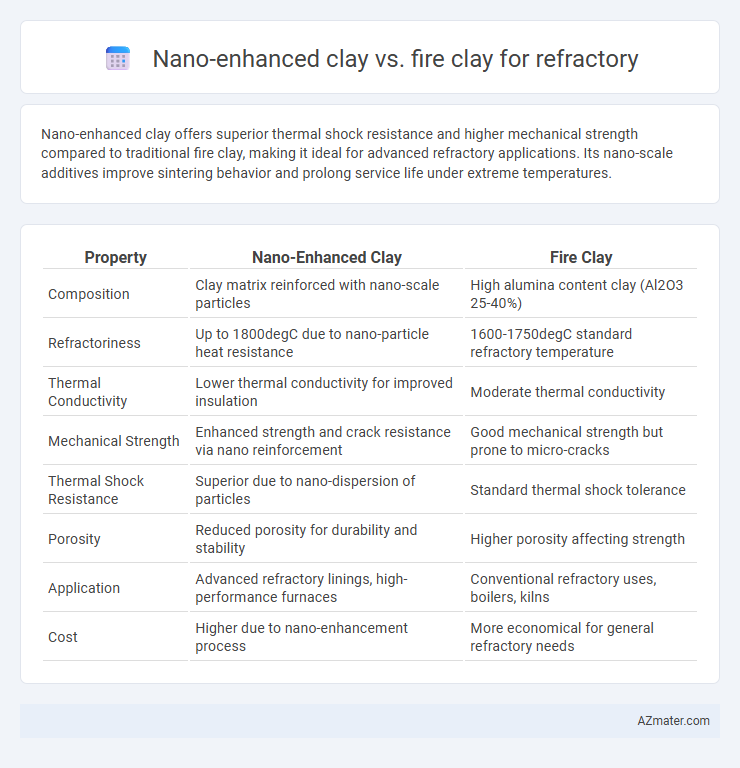Nano-enhanced clay offers superior thermal shock resistance and higher mechanical strength compared to traditional fire clay, making it ideal for advanced refractory applications. Its nano-scale additives improve sintering behavior and prolong service life under extreme temperatures.
Table of Comparison
| Property | Nano-Enhanced Clay | Fire Clay |
|---|---|---|
| Composition | Clay matrix reinforced with nano-scale particles | High alumina content clay (Al2O3 25-40%) |
| Refractoriness | Up to 1800degC due to nano-particle heat resistance | 1600-1750degC standard refractory temperature |
| Thermal Conductivity | Lower thermal conductivity for improved insulation | Moderate thermal conductivity |
| Mechanical Strength | Enhanced strength and crack resistance via nano reinforcement | Good mechanical strength but prone to micro-cracks |
| Thermal Shock Resistance | Superior due to nano-dispersion of particles | Standard thermal shock tolerance |
| Porosity | Reduced porosity for durability and stability | Higher porosity affecting strength |
| Application | Advanced refractory linings, high-performance furnaces | Conventional refractory uses, boilers, kilns |
| Cost | Higher due to nano-enhancement process | More economical for general refractory needs |
Introduction to Refractory Materials
Refractory materials are engineered to withstand extreme temperatures and harsh chemical environments, essential in industries such as steelmaking and ceramics. Nano-enhanced clay offers superior thermal shock resistance and improved mechanical strength compared to traditional fire clay due to the unique properties of nanoparticles integrated into the matrix. Fire clay, rich in alumina and silica, remains a popular choice for basic refractory applications but lacks the enhanced durability and performance found in nano-enhanced alternatives.
Understanding Fire Clay: Composition and Uses
Fire clay, composed primarily of kaolinite with alumina content ranging from 25% to 40%, exhibits excellent heat resistance and plasticity, making it ideal for refractory applications such as brick linings in furnaces and kilns. Its ability to withstand temperatures up to 1,500degC ensures durability in high-thermal environments. Compared to nano-enhanced clay, fire clay emphasizes traditional thermal stability and mechanical strength without nanomaterial additives.
Nano-Enhanced Clay: Technological Advancements
Nano-enhanced clay exhibits superior thermal stability and mechanical strength compared to traditional fire clay, driven by the incorporation of nanoparticles that refine the microstructure and increase surface area. These technological advancements improve heat resistance, reduce wear, and enhance refractory lining lifespan in high-temperature industrial applications. Fire clay, while reliable, lacks the nano-scale modifications that enable enhanced durability and thermal conductivity in next-generation refractory materials.
Comparative Thermal Resistance
Nano-enhanced clay exhibits superior thermal resistance compared to traditional fire clay due to the integration of nanoparticles that improve heat distribution and reduce thermal degradation. Fire clay, while naturally refractory, has a lower melting point and is more prone to thermal shock under extreme temperatures. The enhanced microstructure of nano-enhanced clay results in higher thermal stability, making it ideal for applications requiring sustained high-temperature performance and durability.
Mechanical Strength: Nano vs Fire Clay
Nano-enhanced clay exhibits significantly higher mechanical strength compared to traditional fire clay due to the incorporation of nanoparticles that improve particle bonding and reduce microstructural defects. Fire clay, while durable and heat-resistant, typically has lower flexural and compressive strength owing to its coarser grain size and less uniform microstructure. The use of nanotechnology in refractory clays enhances toughness and thermal shock resistance, making nano-enhanced clay ideal for high-stress industrial furnace applications.
Chemical Durability and Corrosion Resistance
Nano-enhanced clay exhibits superior chemical durability and corrosion resistance compared to traditional fire clay due to its refined particle size and increased surface area, which enhance bonding and reduce porosity. The incorporation of nanoparticles improves resistance to slag and alkali attacks commonly encountered in high-temperature refractory environments. Fire clay, while effective, typically shows lower resistance to chemical degradation and slag corrosion, making nano-enhanced clay a preferred choice for advanced refractory applications requiring extended service life.
Energy Efficiency and Heat Retention
Nano-enhanced clay exhibits superior energy efficiency in refractory applications due to its reduced thermal conductivity and improved heat retention at high temperatures compared to traditional fire clay. The incorporation of nanoparticles creates a denser microstructure, minimizing heat loss and enhancing the insulation performance under extreme thermal cycles. Fire clay, while durable, typically offers lower heat retention and higher thermal conductivity, making nano-enhanced clay a more effective choice for energy-saving refractory linings.
Cost Analysis and Economic Feasibility
Nano-enhanced clay offers superior thermal stability and reduced sintering temperatures compared to traditional fire clay, potentially lowering overall energy costs in refractory applications. While the initial investment for nano-enhanced clay is higher due to advanced processing techniques, long-term savings arise from improved durability and extended service life. Economic feasibility depends on balancing upfront material expenses with operational cost reductions, making nano-enhanced clay more viable for high-performance, cost-sensitive refractory systems.
Environmental Impact and Sustainability
Nano-enhanced clay refractories exhibit superior thermal efficiency and longer lifespan, reducing the frequency of replacements and minimizing raw material consumption. Fire clay, while naturally abundant and recyclable, has higher energy demands during processing due to its coarse structure. The incorporation of nanotechnology in refractory materials promotes sustainability by lowering carbon emissions and enhancing resource utilization compared to traditional fire clay options.
Future Prospects and Industry Applications
Nano-enhanced clay demonstrates superior thermal shock resistance and improved mechanical strength compared to traditional fire clay, making it ideal for advanced refractory applications in steelmaking and glass production industries. The incorporation of nanoparticles enhances sintering characteristics and extends service life, positioning nano-enhanced clay as a key material for next-generation high-temperature furnaces and reactors. Increasing demand for energy-efficient and durable refractory materials drives innovation and adoption of nano-enhanced clay within petrochemical and aerospace sectors.

Infographic: Nano-enhanced clay vs Fire clay for Refractory
 azmater.com
azmater.com